Evolution of Bollywood film industry from Bombay , Mollywood from Mumbai..Masala Richness
Celebrity News, Funny Junk, Interesting Stuff, Music Video, Wonderful Things
Are Bollywood movie producers know that the easy money is in copying a Hollywood movie, remaking it in Hindi and adding masala (singing, dancing, action, romance, fighting, clowning) , aren’t you agree , may or maybe not ?
In the memorizing sequence of Bollywood:- What?Where?When?Who?&How?.Let’s find out.
Amitabh Bachchan

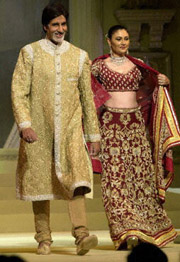

Bollywood:
the mere word conjures up colorful and vibrant dream-like versions of reality. A reality far from the truth but which represents a cultural stereotype of Indians held by firangis (foreigners) and, unfortunately, a fictitious culture that most Indians themselves intimately identify with. To understand where these stereotypes originate and why these illusions are a big part of Indian culture is to get to the core of Bollywood. The word itself is, of course, a play on the word Hollywood, representing Indian cinema’s equivalent commercial production output.
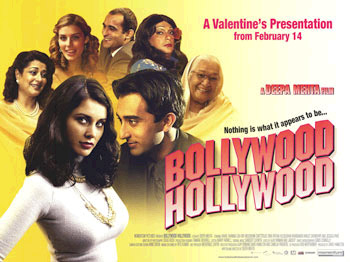
Bollywhat?
There has always been a bit of derision associated with the word Bollywood. At some time or another almost everyone has probably eyed snippets of this cinematic world at Indian restaurants or grocery stores and maybe even delighted in the images of men in tight faded jeans and chest-hugging tank tops and women in ornate costumes dancing atop trains and playing peek-a-boo around trees. But even if you’re unable to understand what is going on, you can’t help but wonder; you can’t help but be taken in.
Those snippets actually represent a mere fraction of an Indian film. In order to fully appreciate a Bollywood movie, you have to be ready to settle in for the long haul because each movie is typically three to four hours long. If you were to spend all your waking life watching just newly released Bollywood films, you would not be able to keep up with all the movies that are churned out. This is because Bollywood makes well over a thousand movies a year. The assembly-like production constitutes more than a quarter of the world’s films and generates more revenue than Hollywood.
So what makes a film uniquely Bollywood? In the course of spending practically the whole evening watching one to find out, you’ll notice some distinct characteristics.
The sheer richness of the films’ “masala” (a term used to describe a mix of several herbs and spices) style makes Bollywood one of the most unique genres of world cinema and allows the directors plenty of creative leg-room to invoke energy, pleasure and emotional response from as large an audience as possible. While Hong Kong cinema is known for its radical compression, Bollywood films stray in all directions. The basic story formula revolves around boy meets girl, boy and girl fall in love and struggle for family approval. But the central storylines almost always branch off into a number of subplots of varying relevance. A catch-all heterogeneous structure is adopted in which several conventions – a love story, a comedic segment, some violent action, the infamous song/dance sequence – are amalgamated to the central braid of interwoven narratives.
Another feature unique to Bollywood are the numerous song and dance sequences in every film. The movies leave little to the audiences’ imagination and consequently their intellect by literally vocalizing every scene and narrating almost all situations. Anything that can’t easily be acted out – for example, themes of love and sexuality – will be played out in song and dance.
Until recently, the movies never even showed kissing (Amit Saxena’s very recent Jism being one of the few exceptions), an act considered sexually tame by Western standards but seen as sinful by Bollywood censors. Nevertheless, this wholesomeness is sometimes overshadowed by song-and-dance sequences that often elicit a much more provocative and sensual feeling. Lovers in the movies rarely get beyond hand-holding, yet water scenes are very popular as leading ladies sing and dance in a river or on a beach and (though fully clothed) leave little to the imagination.
Bollywhere?
Just as “Hollywood” describes both the film industry and the city in which it first thrived, “Bollywood,” too, is named after a city. Journalists unofficially invented the term in the 1970s in connection with the city where the majority of the production happens: Bombay, India. (Since then, the city has officially been renamed Mumbai, although the term “Mollywood” just hasn’t caught on.) Bollywood, however, doesn’t represent India’s entire cinema output. Bollywood produces primarily northern Indian films, mostly in Hindi. In the southern parts of India, mainly Tamil Nadu, distinct film industries churn out films in languages such as Tamil, Bengali, Gujarati, Telugu, Malayalam, Kannada, and Marathi. But there is no denying that Bollywood represents the largest film industry and has the widest audience within and outside of India.
Currently, there are around 12,000 movie theaters in India, ranging from small ramshackle neighborhood screening rooms to overly extravagant movie halls. Compared to the roughly 37,000 screens in the US, it’s hard to believe that Indian theaters can cater to a population of over a billion people. Every theater follows the same format when screening films. Unlike here in the US, people don’t get their snacks before the movie but rather have a 15 to 30 minute intermission when they are able to grab their munchies and discuss what they’ve seen so far. For most Indians, these movie halls are the only major source of entertainment, so for the more than 20 million daily moviegoers, going to the movies is as much an event as the film itself. This often makes watching a film a whole day’s affair.
From their initial inspiration to post-production, most movies are made in Mumbai, but when it comes to actual shooting locations, Bollywood filmmakers tend to venture elsewhere. Kashmir used to be a favorite backdrop for many musical scenes, but due to the territorial conflict between India and Pakistan, that has slowly come to a halt. Nowadays, as Bollywood is becoming more profitable and productions have larger budgets, it is not uncommon to cross travel outside of India for exotic locations, including Switzerland, Australia, New Zealand and South Africa. In fact, Durban, South Africa is slowing becoming Bollywood II, as top industry filmmakers slowly make it their secondary destination (some people have even dubbed it “Dollywood,” but perhaps Dolly Parton would have something to say about that.)
Many things Indian are embraced around the world. For example, there has always been a Western audience for Indian films such as Satyajit Ray’s classic Apu Trilogy (Pather Panchali [1954], Aparajito [1957] and The World of Apu [1959]) but they tend to be limited to independent screenings and film schools due to their “art house” categorization. Likewise, Indian food, music, yoga, spirituality, etc., are becoming more and more popular with expatriates, non-resident Indians (NRIs) or Indians living outside of their homeland and, yes, even firangis. Because of the rise in popularity of things Indian, Bollywood films have begun to appeal to audiences outside of India. Consequently, Bollywood exports its films to 95 countries worldwide, a majority of them going to the US, UK and Canada.
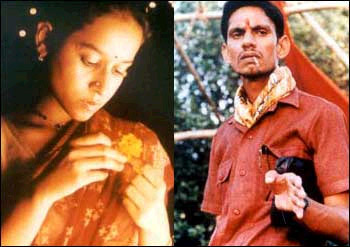
Tilotama Shome and Vijay Raaz, in Monsoon Wedding
Here in the US and other parts of the West, movie theaters that screen only Indian films are slowing popping up in major cities, becoming congregating points for many South Asian communities (mostly NRIs). But Bollywood’s mushrooming popularity is manifested in recent films that have made their way into mainstream movie theaters, including Mira Nair’s Monsoon Wedding (2002), which has captivated western audiences with it amazing soundtrack, Lagaan (Land Tax, 2001), which was a Best Foreign Film Oscar nominee, and Kabhi Khushi Kabhi Gham (Sometimes Happiness Sometimes Sorrow, 2001) which broke box office records for a Bollywood film in North America and actually made it to the top ten list for about a week in the US. In addition, the influence can be felt in the production of homage films like The Guru (2003) and Bollywood Hollywood (2002) – but why go for imitation when you can have the real thing?
Bollywhen?
The origins of Bollywood date as far back as the 1890s, making it as old as Hollywood. Motion pictures were screened in India for the first time more than a century ago by the Lumière Brothers’ Cinematograph, and, in 1899, Harishchandra Bhatvadekar shot India’s first movie. But it took a while for India’s motion picture industry to really get rolling. The first feature film (that wasn’t just a filmed stage play) to be produced in India was Raja Harishchandra (1913), but the integration of sound to visuals didn’t arrive until the 1930s, and it wasn’t until 1952 that the first Indian film festival came about.
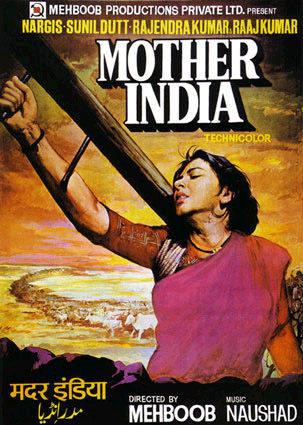
Mother India, 1957 ….
Broadway Mamamia …???
Bollywood’s credibility has been slow to gain recognition. A major turning point happened in 1955 with the first Indian film to be recognized by the outside world, when Satyajit Ray received “Best Human Document” at Cannes for Pather Panchali in 1955. Three years later, Mother India, the seminal epic allegory about a rural family, was nominated for best foreign film at the Academy Awards. It then took another 30 years before Salaam Bombay (1988) was nominated for an Academy Award, and another 14 years after that before Lagaan received an Oscar nomination. However, recent trends, with films like Devdas (2002), which received numerous awards and recognition, hint that things may be changing.
Bollywood has grown dramatically, always quick to adopt a multi-faceted blend of artistic expression, entertainment star power, commercialism, and globalization. This evolution is continually revolving around social and cultural changes and is manifested in the more than 67,000 Bollywood films that have been made.
Bollywho?
Bollywood films aren’t Bollywood without the movie stars. Whether or not a film is a flop is heavily dependent on who stars in it. Just like here in the States, nearly every well-known film actor has starred in at least one bad movie, sometimes more than one at a time. Films are produced so fast that there are occasions where actors shoot scenes for four different films at the same location – often using the same production crew and backgrounds. With all those movies being made at the same time and place, high profile film stars can end up having to compete for the same time and space. It’s a tricky business, but filmmakers have to make sure all their top-billed actors have equal screen time without anyone overshadowing any of the others. For example, take Karan Johar’s Kabhi Khushi Kabhi Gham, which features three of the industry’s elite actors, Amitabh Bachchan, Shah Rukh Khan and Hrithik Roshan. It has been reported that no tension existed among them during the shoot because all three independently play important roles and share equal screen time.
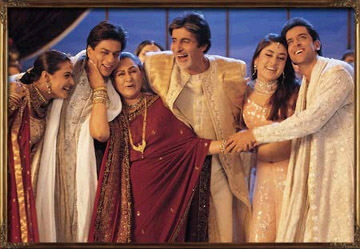
The cast of Kabhi Khushi Kabhi Gham, with Bachchan at center
Tagged “Mr. Bollywood” by some, Amitabh Bachchan has been in the industry for over 30 years and is considered one of the most popular people in the world due to the sheer enormity of India’s population. He even topped a BBC News Online poll of the greatest stars of stage and screen, ahead of Laurence Olivier and Robert De Niro (and even Homer Simpson). To know Bollywood is to know Amitabh Bachchan. Other Bollywood veterans include Raj Kapoor in Sangam (1964), Rajesh Khanna in Mehbooba (1976), Raj Kumar in Mother India (1957), Dharmendra in Sholay (1975) among many others. Bollywood’s younger and hipper generation includes “heart-throb” Hrithik Roshan who caused a riot among thousands of students at a movie theater in Nepal, in which two protestors were shot by the police just because the actor was misquoted as saying he didn’t like Nepalese. Other contemporary actors include “the triple Khans”: Shah Rukh Khan (Devdas), Salman Khan (Maine Pyar Kiya ) and Aamir Khan (Lagaan).
Bollywood actresses are equally revered. Some of the more notable veterans include Nargis in Mother India, Hema Malini (Sholay), and Rekha (Silsila), among many more. Newcomers have also paved their way into the hearts of fans. Favorite upstarts include the striking Karishma Kapoor (1997’s Dil To Pagal Hai), her younger sister Kareena Kapoor (2001’s Yaadein), Kajol (Kuch Kuch Hota Hai), Aishwarya Rai (Taal , Madhuri Dixit (Dil to Pagal Hai), Preity Zinta in Dil Chahta Hai) and the list goes on and on.
Obviously, as with any other movie industry, directors are an integral part of the process, too, although they don’t get the “auteur” treatment filmmakers may recieve in other cultures. Some of the more notable ones include Manmohan Desai (director of 1977’s inspired and looney Amar Akbar Anthony), Mehboob Khan (Mother India), Karan Johar (Kabhi Khushi Kabhi Gham, Kuch Kuch Hota Hai) and Yash Chopra.
Bollywood films would be barren without all the exuberant song and dance sequences, thus a lot of credit for the success of these films needs to go to the music directors. The more popular music directors include Anu Malik (Chori Chori Chupke Chupke, Baazigar), the prolific A.R. Rahman (Lagaan, Fiza, 1947/Earth, Fire), whose work is a favorite at GreenCine, and Jatin Lalit (Kuch Kuch Hota Hai and the fun romance Ghulam). Because it’s acknowledged that many Bollywood fans consider the music parts “the good stuff,” there are now DVDs devoted solely to music videos – the best musical scenes from various films (Bollywood Hits Vols. 1-3 is one such example), in addition to the many soundtracks and compilations now more readily available on compact disc.
Bollyhow?
With a slew of East-meets-West themes in recent films like Deepa Mehta’s Bollywood/Hollywood (2003), Mira Nair’s Monsoon Wedding, P.D. Pandya’s American Desi (2001) and stage spin-offs like Bombay Dreams by Andrew Lloyd Webber, it is obvious that Bollywood is being enjoyed by more people than ever before. But Bollywood’s enormous production and unfamiliar format may leave a neophyte lost and intimated.
Fortunately, an introduction to Bollywood isn’t by any means difficult to come by. While these movies used to be only available in the form of mostly pirated videotapes at “Qwality Marts” (Indian grocery stores) and the like, never fear! As Greencine members, you have access to a great collection of Bollywood favorites on subtitled DVDs that also often include nifty extra features you can view – if you survive the 3-4 hour running time and are still longing for more!
Take a leisure video clip watch of Bollywood Arts and Culture Entertainment
September 20th, 2007 at 7:32 am
when you say it’s ove. Zaid Bethanie.
May 19th, 2010 at 6:59 pm
pleassure videos coming up minort persons ilkike m,lj